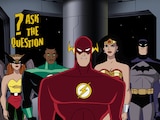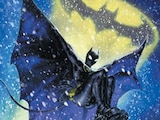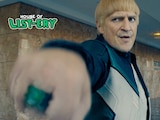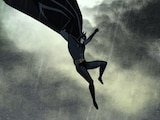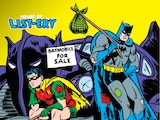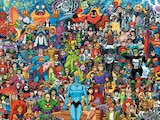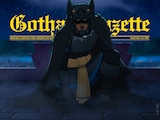Attempting to adapt Marv Wolfman and George Pérez’s Crisis on Infinite Earths is no small feat. I don’t think it’s at all controversial to say that Wolfman and Pérez were one of the greatest creative duos in the history of comics. From the grandiose scale of Wolfman’s scripts to the iconic detail of Pérez’s artwork, there’s a reason why the iconic limited series continues to loom large in the psyches of fans. So, how on earth does one go about adapting a story like Crisis for animation?
Well, to start, you don’t try to fit it all into one film. Justice League: Crisis on Infinite Earths – Part Three is the final part of an animated trilogy that not only adapts the classic comic book event, but also serves as the final film in the connected “Tomorrowverse” of films that started with 2020’s Superman: Man of Tomorrow. While the full Crisis on Infinite Earths trilogy, of course, takes the premise of Wolfman and Pérez’s original story and uses characters like Harbinger, the Monitor and the Anti-Monitor, director Jeff Wamester’s climactic third film builds on the mythology of previous animated movies like Justice League: Warworld, Justice League Dark: Apokolips War, Green Lantern: Beware My Power, and hell, even the Kamandi and Losers animated shorts from Constantine: The House of Mystery. Crisis on Infinite Earths – Part Three isn’t trying to compete with Wolfman and Pérez’s comic. Instead, it borrows the basic framework of the original Crisis in order to tell a story that’s perhaps better suited for the medium of film.

This is an approach that makes sense, given that the existing array of DC animated movies is quite different from the sprawling library of DC comic books at the time of the original Crisis. Something that I have always liked about the DC animated films is that they’re not comics, nor do they always offer a 1:1 direct adaptation. Other fans may not feel this way, but personally, I’ve always welcomed the creative liberties taken in the DC animated movies. I’ll always have my comics to fall back on if I don’t like how a particular story was adapted, and at the end of the day, it’s always intriguing to see how another group of artists interprets the characters and stories that you love.
It’s clear, then, that Crisis – Part Three is a celebration of the many corners of the DC Universe that DC’s animated movies have explored these last few years. I loved seeing the Losers charge in early on in the film, pursuing a pack of dinosaurs. Sure, it’s totally out of place, but that’s the point. The DCU contains an unapologetic mishmash of various genres and time periods, and Crisis – Part Three provides a place to say, “Hey, all of these pieces matter to the broader tapestry.” As a big Jack Kirby fan, I was over the moon to see Kamandi with a larger role in this film, and I really hope that his continued presence will get more fans reading his comics.

Crisis on Infinite Earths – Part Three also takes this a step further when it reveals that the other Earths threatened by the Anti-Monitor are, in fact, the Earths from previous animated universes. I was shocked first to see the Super Friends’ Earth get destroyed, before getting absolutely verklempt by Kevin Conroy’s final line as the Batman: The Animated Series Earth was wiped. It was a fitting but bittersweet moment for me, as someone whose love of comics, Batman and the DC Universe at large began with that groundbreaking series.
On a brighter note, I appreciated how the film recognized something I have spent much time in the fan trenches arguing: that John Stewart is the best Green Lantern. When he was addressed by his fellow Lanterns as “the legendary John Stewart, the greatest of the Green Lanterns,” I nearly hopped out of my seat like I was watching a game-winning touchdown at the Super Bowl. I loved Green Lantern: Beware My Power, the movie that introduced John to the Tomorrowverse, because it celebrated how his headstrong and discerning personality makes him a better Lantern. I have to be thankful that Crisis on Infinite Earths continued to honor this aspect about his character.

Besides, even though John Stewart is the best Green Lantern (okay, your opinion might be different, but I’m very much Team Stewart), he never lets that go to his head. This was echoed during the sequence when he and his fellow Lanterns hold the line against the Anti-Monitor. The greatest Green Lantern is always at his best when he’s in the company of his fellow GLs. John Stewart knows to share the wealth.
With Justice League: Crisis on Infinite Earths – Part Three now out, it looks like the start of a new chapter for DC animated films has begun. For me, I can’t argue with the sheer diversity of genre and character that this phase has brought us. Catching glimpses of characters like Mister Miracle and Big Barda gives me hope that one day we can have an animated film that explores all sides of New Gods lore, not just Darkseid. Or what about heroes like Adam Strange, Doctor Light and the Question? The Spectre? Captain Atom? The possibilities look, well, infinite.
Justice League: Crisis on Infinite Earths – Part Three is now available on 4K UHD, Blu-ray and Digital. Get caught up on the first two parts right now on Max.
Jules Chin Greene writes about comics, TV, games and film for DC.com, and his work can also be found at Nerdist, Popverse and Multiverse of Color. You can follow him on Twitter and Bluesky at @JulesChinGreene.
NOTE: The views and opinions expressed in this feature are solely those of Jules Chin Greene and do not necessarily reflect those of DC or Warner Bros. Discovery, nor should they be read as confirmation or denial of future DC plans.


